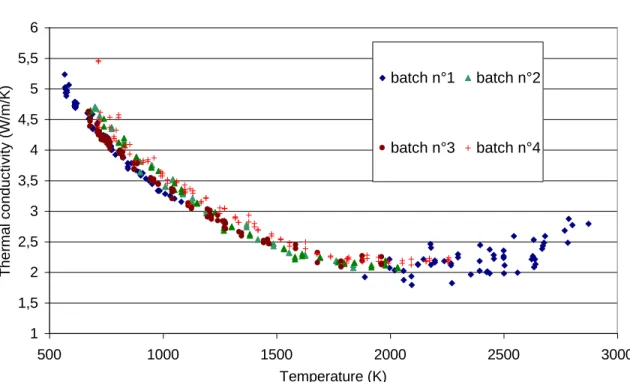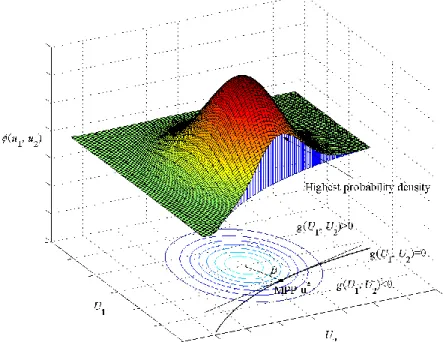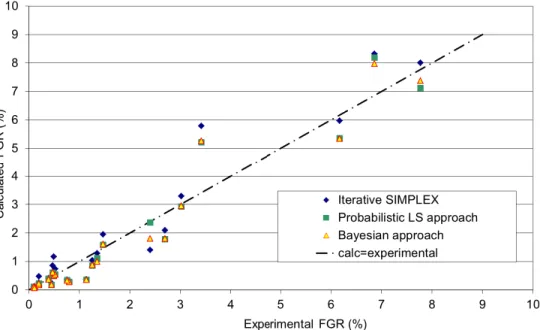HAL Id: cea-02339115
https://hal-cea.archives-ouvertes.fr/cea-02339115
Submitted on 13 Dec 2019
HAL is a multi-disciplinary open access
archive for the deposit and dissemination of sci-entific research documents, whether they are pub-lished or not. The documents may come from teaching and research institutions in France or abroad, or from public or private research centers.
L’archive ouverte pluridisciplinaire HAL, est destinée au dépôt et à la diffusion de documents scientifiques de niveau recherche, publiés ou non, émanant des établissements d’enseignement et de recherche français ou étrangers, des laboratoires publics ou privés.
behavior modelling and simulation
A. Bouloré
To cite this version:
A. Bouloré. Importance of uncertainty quantification in nuclear fuel behavior modelling and simula-tion. BEPU 2018, May 2018, Lucca, Italy. �cea-02339115�
IMPORTANCE OF UNCERTAINTY QUANTIFICATION IN NUCLEAR FUEL BEHAVIOR MODELLING AND SIMULATION
A. Bouloré
CEA, DEC/DEC Fuel Research Department, Centre de Cadarache, 13108 Saint Paul lez Durance, France
antoine.boulore@cea.fr
ABSTRACT
This paper presents some applications of uncertainty quantification and sensitivity analysis use in fuel behavior simulation process. It can be essential in all the simulation process: code/model calibration, validation and usage for safety analysis.
1. INTRODUCTION
The aim of a fuel performance code is to describe the physical phenomena occurring in the fuel during its irradiation in reactor and to calculate the evolution of some physical quantities (like geometry, inner pressure, stresses, and temperature) which can be used directly in safety assessment of the fuel. In most cases, a fuel performance code is made of several coupled models, each of them describing one particular physical phenomenon (thermal transfer, fission gas behaviour, mechanical behaviour, cladding corrosion …). A typical coupling scheme is presented on Figure 1.
Fuel performance codes are deterministic codes, but a lot of data (material properties, experimental results…) used in these codes are uncertain. In this paper, we try to show how important it is to take into account these uncertainties in the use of a fuel performance code and what can be the consequences.
Figure 1 – Coupling scheme of ALCYONE fuel performance code [1].
2. WHY UNCERTAINTY ANALYSIS IN FUEL MODELLING?
In the frame of nuclear fuel behaviour modelling and simulation, due to the difficulties associated to measures under irradiation, it is very often not possible to obtain a reasonable value of material properties by direct measurements. Then the determination of the model physical parameters is very often not direct which induces numerous sources of uncertainty coming from different topics.
- Material properties: in many cases, material properties are measured directly by specific experimental techniques, and very often, the experimental data are scattered. There is an uncertainty due to the technique itself, but also an uncertainty linked to the representativeness of the chosen sample. It is the case for experimental data of fuel thermal conductivity, fresh or irradiated (ex. Figure 2).
- Experimental conditions used for validation: a typical quantity which is uncertain is the power at which the rod is irradiated during an experimental irradiation. And it is a parameter of first order of all the schemes in fuel performance codes.
- Experimental results which are used to validate/calibrate the different models of the fuel performance codes. For example:
Fission gas release measurement which is an integral quantity used to validate the fission gas behaviour model.
Temperature measurements in irradiation devices also have an uncertainty, and this quantity is used to validate the global thermal model of the code. - Model parameters. Some model parameters can be measured directly (like material
properties mentioned above), but very often, specific experiments are conducted which allow a determination of the parameters using inverse method. It means that a specific model is built to extract basic data from the experiment. A good example of such parameter is diffusion coefficients. In this case, the uncertainty is linked to both experimental data/conditions uncertainties, and to the degree of simplification of the model.
- Modelling uncertainty is more difficult to represent and quantify. In fact a model is always a simplified mathematical representation of a complex physical phenomenon. Assessing the modelling uncertainty consists in a quantification of the error made when simplifying the representation. It is a very difficult task.
Figure 2 - Scattering of experimental data for fuel thermal conductivity.
Two main objectives can be listed to justify the need of uncertainty analysis.
First, it is a way to improve the degree of confidence of the fuel performance code by demonstrating that in the global simulation/modelling process, uncertainties on the calculated quantities are being quantified. In this objective, propagation on input uncertainties in the code is important in the global validation process of the code (showing that the experimental results used for validation are in the range of uncertainty of the calculated results [2]). Sensitivity analysis helps to determine which uncertain parameter or data is the most sensitive on the outputs of the
1 1,5 2 2,5 3 3,5 4 4,5 5 5,5 6 500 1000 1500 2000 2500 3000 Temperature (K) T h e rm a l co n d u c ti vi ty (W /m /K ) batch n°1 batch n°2 batch n°3 batch n°4
fuel performance code. It helps then to determine which uncertain inputs have to be more precisely known (reduced uncertainty).
The second topic is safety analysis. As the fuel performance code is a best-estimate code, UQ/SA and probabilistic approaches allow taking into account the uncertainties on inputs and model parameters to make sure that even with some uncertainties, the safety criterion is still verified. It is shown later in the paper that the criterion verification can be replaced by a probability assessment in those cases.
3. GENERAL METHODOLOGY
The methodology used for about 10 years is presented in detail in [3]. The general scheme of this recommendation is printed on Figure 3.
This method is decomposed in 4 steps: problem specification, modelling of the uncertainties, uncertainty propagation phase and eventually sensitivity analysis if required. The first two steps are very often the most difficult; the last two require large computing capacities.
Figure 3 – General methodology recommended for UQ/SA. 4. EXAMPLES OF APPLICATIONS
4.1 Code validation: example on fuel thermal behaviour
To quantify the uncertainty on the temperature calculated by the fuel performance code ALCYONE, uncertainty on the following inputs are taken into account:
- Fuel thermal conductivity
- Radial distribution of power which also leads to the HBS restructuring - Power (or Linear Heat Rate) generated by the fuel rod
- Thermal transfer through the pellet-to-clad gap
Different methods can be used to model these inputs as random variables (expert opinion, inverse methods, iterative methods…). But some of these uncertain input depend on a lot of parameters, and the Morris sensitivity analysis method [4][5] can be used to reduce the number of uncertain parameter. It is a one-at-a-time method which does not require a large set of calculations. The Morris sensitivity indices may depend on the experimental conditions (for example gap open or closed) and the method has to be applied for the experimental conditions of the case.
After the uncertainty modelling phase, uncertainty propagation can be performed by Monte Carlo sampling and direct calls to the fuel performance code. The size of the sample depends on the computation resources available. In the case presented, 10000 simulations of the experiment have been performed and the set of results can be used to determine the uncertainty on the calculated temperature. All experimental data are in the 95% confidence interval of the calculated distributions (Figure 4), so it validates the modelling of the thermal behaviour of the fuel element.
Figure 4 – Validation taking into account uncertainties.
A focus will be done in the presentation on the propagation of this uncertainty on temperature in the other models of the code. The problem is more complex than what it looks like, as all the models are coupled in the fuel performance code, and all models need a calibration phase to make the final code a best-estimate code.
4.2 Safety analysis; application of reliability methods to fuel melting
The second example is about the safety analysis topic. The objective is to determine at which power, a melting of the fuel pellet could occur:
As there are uncertainties on the inputs and parameters used to calculate the fuel temperature, and also on the knowledge of the irradiated fuel melting temperature, the problem of threshold determination is turned into the determination of the probability of melting for a given target power:
The same general methodology is applied to quantify this probability and two types of methods (maybe more) can be used.
Monte Carlo direct sampling requires a large set of simulations but allows an evaluation of the uncertainty on the calculated probability (confidence interval).
Reliability methods like FORM/SORM [6] can also be used and require much less runs of the code (Figure 5Erreur ! Source du renvoi introuvable.). Using FORM/SORM we can evaluate the probability of fuel melting, but also the contribution of each uncertain input to the probability of melting (kind of sensitivity analysis).
But it assumes that the code behaviour is “regular” around the domain of failure, because it needs to evaluate second derivatives which are very sensitive to the precision of calculation and convergence of the global scheme [7].
Figure 5 – FORM/SORM methods. 4.3 Model/code calibration
In the fuel behaviour simulation process, a lot of models contain fitting parameters. In order to make the code a “best-estimate” code, all these parameters have to be adjusted on a set of experiments called calibration database (including the associated experimental uncertainties)
covering as far as possible the domain on which the model is going to be used in the future. This is also part of the global validation process.
As most of the time, the experimental quantities used for calibration have an uncertainty, the statistic and probabilistic approaches can help in the optimization process to determine the uncertainty on the fitted model parameters due to the uncertainty of the calibration database. In the following, an example is given for the calibration process of a fission gas behaviour model [8]. Different types of statistical and probabilistic approaches have been tested (simple probabilistic least-square, Bayesian with linear assumption), all of them giving satisfactory results for the calibration process (Figure 6), and an estimation of the covariance matrix of the vector of model parameters, which represents the uncertainty on the parameters related to the experimental uncertainty.
Figure 6 – Results of the different calibration methods.
Recent work is conducted to use a non-linear Bayesian approach. The method itself is still under theoretical development.
5. CONCLUSION
A lot of data used for fuel behaviour simulation are uncertain:
- Experimental data used to build material properties, or to calibrate models - Experimental conditions,
- Model parameters, …
These uncertainties can have a significant effect on the interpretation of the calculated results, especially if the quantity of interest is a threshold.
In the paper, we have tried to illustrate the different types of sources of uncertainty, and the different steps where uncertainty quantification is important in the simulation process:
calibration, validation, code usage. Whatever the application of the simulation tool (experiment interpretation, safety analysis), it looks essential now to give the results of the simulation plus uncertainties. In the safety analysis for example, instead of determining a maximum power without melting of the fuel by conservative method, the introduction of probability distributions for the uncertain parameters and inputs leads to an evaluation of the probability of failure as a function of the target power [7]. This is more precise information.
6. ACKNOWLEDGEMENT
I would like to thank Christine Struzik, Bruno Michel, Jean-Marc Martinez and Fabrice Gaudier for their direct or indirect contribution to this paper.
7. REFERENCES
[1] V. MARELLE et al., “New developments in ALCYONE 2.0 fuel performance code”, Proc. TopFuel 2016, Boise, ID (USA).
[2] C.STRUZIK, V. MARELLE, “Validation of fuel performance CEA code ALCYONE, scheme 1D, on extensive database”, Proc. TopFuel 2012, Manchester (UK).
[3] E. DE ROCQUIGNY, N. DEVICTOR, S. TARANTOLA, “Uncertainty in industrial practice: a guide to quantitative uncertainty management”. Eds. John WILEY and sons (2008).
[4] M.D. MORRIS, “Factorial sampling plans for preliminary computational experiments”. Technometrics, 33 (1991) 161-174.
[5] F. CAMPOLONGO, A. SALTELLI, “Sensitivity analysis of an environmental model : an application of different analysis methods”. Reliability Engineering and System Safety 57 (1997) 49-69.
[6] XIAOPING DU, “FORM/SORM”, Probabilistic Engineering Design course, Ch. 7, University of Missouri – Rolla (2005).
[7] C. STRUZIK et al., “Determination of the fuel melting probability in MTR using reliability methods”, Proc. WRFPM “TopFuel” 2017, Jeju Island (South Korea).
[8] A. BOULORÉ et al., “Contribution of probabilistic approaches for the calibration of a fission gas release model”, ANS Transactions, ANS Annual Meeting 2015, San Antonio, TX (USA).
![Figure 1 – Coupling scheme of ALCYONE fuel performance code [1].](https://thumb-eu.123doks.com/thumbv2/123doknet/12988314.378988/3.918.275.636.110.531/figure-coupling-scheme-alcyone-fuel-performance-code.webp)




